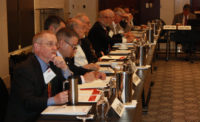The commercial refrigerant landscape is changing. Driven by shifts in technology, policy, regulations, and consumer demands, those managing this sector must surmount these complexities and navigate governmental uncertainty to build a path to sustainability.
Danfoss addressed this evolving sector through its Refrigerants2Sustainability Symposium, Nov. 5 in Washington, District of Columbia — the 22nd meeting in the manufacturer’s EnVisioneering Symposia Series.
Reasoning and Responsibility
Kevin Fay, executive director of the Alliance for Responsible Atmospheric Policy (ARAP), said his organization has been very busy in 2014. The group has been monitoring the implementation of European F-gas rules, which are effective Jan. 1, 2015; examining a developing Japanese fluorocarbon program; observing Australia’s hydrofluorocarbon (HFC) tax; contemplating the future of President Barack Obama’s Climate Action Plan; keeping an eye on domestic HFC and hydrocarbon (HC) regulations; and more.
In January, the group filed a petition with the U.S. Environmental Protection Agency (EPA) to extend the Section 608 rules to include HFCs, and, in February, the group announced its support for a Montreal Protocol amendment.
At an event hosted by the White House in September, ARAP announced its support for policies and actions to achieve an 80 percent reduction of HFCs by 2050 on a global warming potential (GWP)-weighted basis, based on current emissions levels.
“The primary method to achieving this 80 percent reduction in HFC emissions is a Montreal Protocol amendment. The proposed amendment has a funding mechanism to help developing countries and boasts a track record of success that no other international policy forum has,” said Fay.
“So, we think we’ve made considerable progress. We were asked to participate in some meetings and workshops with the government, along with government and industry representatives from India, Saudi Arabia, and China, who have been the main opponents to the Montreal Protocol approach. But, progress is being made, and we are asking what more we can do to move the ball forward.”
While the framework is in place, Fay admits implementing a Montreal Protocol amendment will take an enormous amount of effort.
“We have an awful lot of work to do,” said Fay, who also serves as president of the public affairs firm Alcalde & Fay. “We’ve made tremendous strides in promoting a comprehensive approach to dealing with these issues. But, the work in front of us is quite extensive. The general atmosphere is positive and constructive, but there are a lot of off ramps that could divert progress. Long-term, we’ve established a program and approach that will prove environmentally effective and economically stable.”
The Power of Regulations
Drusilla Hufford, director, Stratospheric Protection Division, EPA, said a focus on HFC regulation is important because, globally — from 2004 to 2008 — HFC emissions increased about 8 percent per year. Left unchecked, such emissions could rise to nearly 20 percent of total carbon dioxide emissions by 2050. As is, HFC emissions are expected to double from current levels of 1.5 percent of greenhouse gas emissions to 3 percent by 2020, and triple to 4.5 percent by 2030.
Through Obama’s Climate Action Plan, Hufford said the EPA intends to use its Significant New Alternatives Policy (SNAP) program to approve climate-friendly chemicals and change SNAP status to unacceptable for some uses of the most harmful chemical alternatives.
Hufford said the Climate Protection Plan calls on federal agencies to lead by example, meaning the federal government will aim to purchase cleaner alternatives to HFCs whenever feasible, which will help facilitate the use of more sustainable, safer alternatives.
“Our preference, within the EPA, is to provide a uniform, global approach. The North American proposal was first submitted under the Montreal Protocol Parties in 2010, and that treaty’s global approach of control and management has proven effective. SNAP is a domestic tool the president — through his Climate Action Plan — has directed us to use, and we are using it judiciously. This first rule, which will add a host of low-GWP refrigerants, continues the approach SNAP has followed for quite some time.”
Further SNAP proposals include changing the listing status of R-134a for use in certain aerosol end uses in 2016, certain foams end-uses in 2017, and automobile air conditioning in 2021.
Hufford also provided insight into EPA’s refrigerant management strategy established under Section 608 of the Clean Air Act, which prohibits knowingly venting refrigerants and provides requirements for leak repairs and prevention and service practices for safe disposal of chlorofluorocarbons (CFCs) and hydrochlorofluorocarbons (HCFCs).
Finally, Hufford reaffirmed the recently announced HCFC-22 phaseout timeline, stating the EPA is very proud of that announcement.
Refrigerant Roundtable
More than 50 thought leaders from industry, policy utilities, and research executives attended the event and shared a lively conversation regarding some of the sector’s most pressing issues during a roundtable discussion.
“We need to talk about contractors servicing equipment, the challenges they have, and the rest of that servicing downstream,” said Maureen Beatty, vice president of operations, National Refrigerants Inc. “I’m not aware of any recovery equipment [for HCs] in the marketplace. Who’s going to take this material back? Currently, the EPA is supposed to allow the venting of small charges of isobutene. For consistency of the industry, in understanding how to service these systems, it’d be very helpful if the EPA would consider these things from the start when approving some of these fluids under its SNAP program. If we don’t think it through, we’re going to be doing the industry a disservice.”
Charlie Hon, engineering manager, True Mfg., said options are available — they’re just not well publicized.
“Not everyone is up to snuff on new technologies,” he said. “The EPA had information on a lot of these refrigerants before they made their SNAP rulings. There are options out there. They’ve [SNAP] done safety reviews and we manufacture and sell a capture system for hydrocarbons, which traps the volatile organic compounds (VOCs) so that they aren’t released into the atmosphere.”
Keilly Witman, owner, KW Refrigerant Management Strategy, Berkeley, California, said many supermarket owners are finding it easier to simply eliminate the role of the service tech. “It seems like the more we talk about how service techs are not trained to deal with these types of refrigerants, the more I hear about supermarkets preferring self-contained systems. There’s no installation with self-contained units. It doesn’t matter if service techs are trained or not. Supermarkets are hearing about the lack of training and are already starting to consider, ‘Is it worthwhile to avoid this installation process completely?’”
Tim Anderson, principal engineer, display cases and micro-distributed systems, Hussmann Corp., reiterated just how simple the new systems can be: “You connect them to water, connect them to power, and they run. You don’t touch them. There’s no superheat adjustment — you just let them run.
“Now, it’s naïve to think these units will never need service,” he continued. “That’s where proper service maintenance and training is important, though these systems are designed to be a much lower maintenance system than we’re used to.”
Witman said everyone — the contractor, manufacturer, store owner, and consumer — benefits from increased awareness. Contractors play a vital role in the way commercial refrigeration equipment is installed and maintained, so it’s important they stay engaged in the regulatory changes and technical advances for low-GWP solutions.
For more information on the Danfoss EnVisioneering Symposia Series, visit http://bit.ly/DanfossEnvisioneering.
Publication date: 12/22/2014
Want more HVAC industry news and information? Join The NEWS on Facebook, Twitter, and LinkedIn today!













